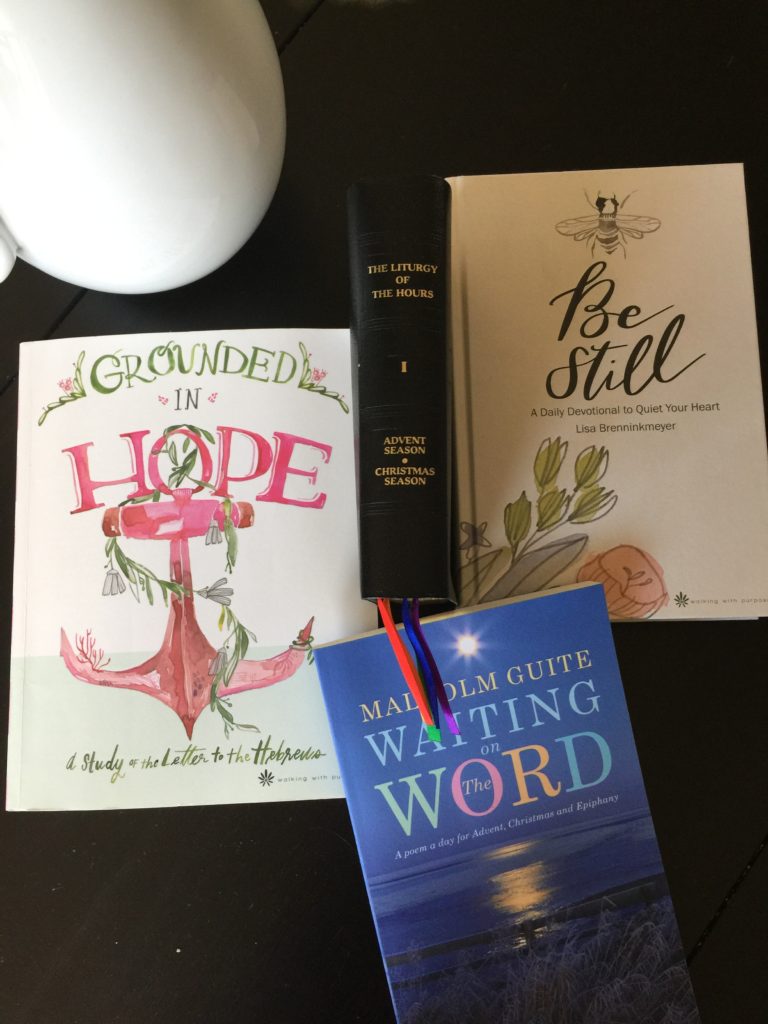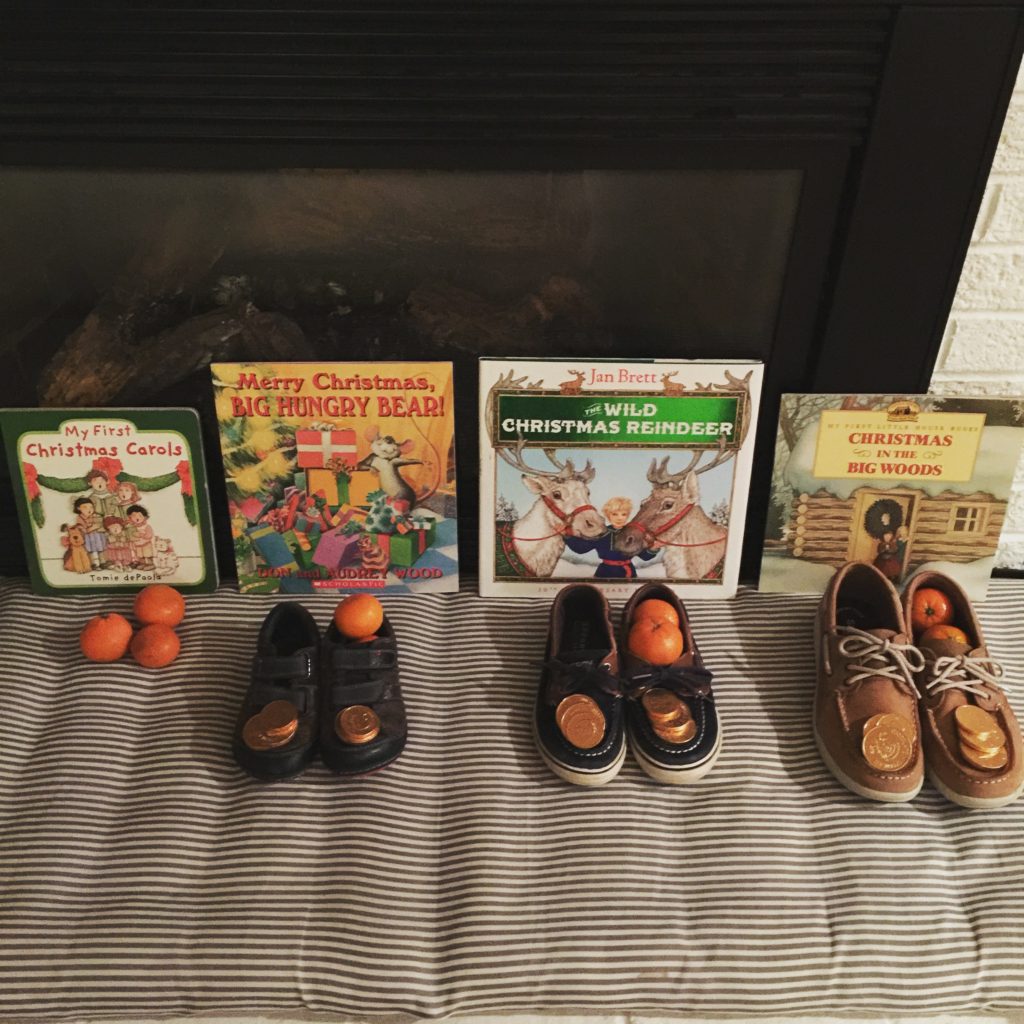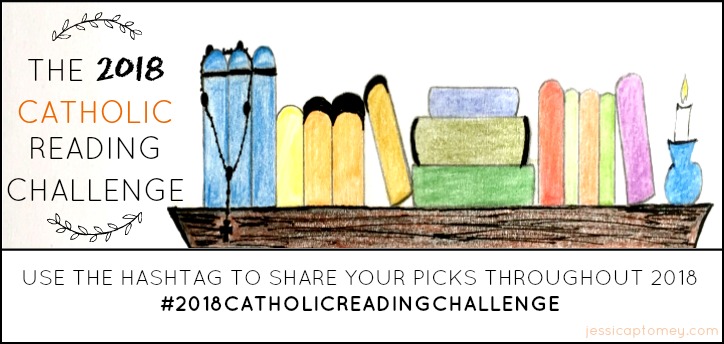It’s that time. The liturgical year of the Church is drawing to a close, and we start again. Advent. This is perhaps the most difficult season in which to live intentionally, at least at first. But I find, being a convert to Catholicism, that as the years go by and liturgical habits take deeper root, the resting/waiting/reorienting becomes second-nature. I thought I would share some of my (*planned*) habits for this Advent season, and perhaps they will spark ideas for your life and family rhythms.
What I’m reading/contemplating/praying…

Here’s what’s in my book stack:
- The Liturgy of the Hours — I don’t think that we can pick better for ourselves than what the Church has already selected for us to be praying and reading together. I’m excited about the Psalms, prayers and antiphons that await me during Morning Prayer and the selections from the Office Of Readings that I will be reading and praying with my husband.
- Grounded in Hope Bible study — I lead a Walking With Purpose (WWP) study in my home (I’m also the co-ordinator for the program at my parish if you are local and want to join a study!), and this year my group is working through Grounded in Hope: A Study of the Letter to the Hebrews. As always, the topic for the lesson we are currently on seems perfectly timed: REST! There is so much good Scripture and truth on this topic to apply during my Advent journey.
- Be Still — Lisa Brenninkmeyer, the founder of WWP, just released a beautiful devotional for women that is full of reflections on Scripture and catechism passages. My husband surprise-gifted it to me (just ’cause he’s awesome), and I’m excited to have it in my reading stack. And yes…God’s clearly echoing this theme of “resting” in Him.
- Waiting on the Word: A Poem a Day for Advent, Christmas and Epiphany — I’m so excited to jump into this one! This year I resolved to always be in a book of poetry, reading at least one poem a day. At the beginning of the year I discovered Malcolm Guite’s poetry compilations. He has a book for Lent as well, which was my Lenten poetry, and it was wonderful. If poetry isn’t part of your life, I encourage you to adopt the practice of “a poem a day”. This book during the season of Advent would be a great way to start this habit…and kick off the new liturgical year!
What I’m listening to…

Last year I revamped and shared my Spotify Advent playlists — traditional and contemporary — that I play aloud in our house throughout the days of Advent. So I have those; but our friend Fr. Matt Fish has shared his curated Advent playlist on Twitter, and it is fantastic. It will be on repeat around here! I think that intentional music selections are such a wonderful way to set the liturgical tone in the home, helping us to all enter into the message and waiting of Advent and then into the message and celebration of Christmas. The thing is, there is more amazing Advent-themed music out there than you have time to listen to through all of Advent; you just need to have it ready to go. So just click, “follow,” and you are all set!
What I’m doing with my family…
We continue our meaningful family traditions from years past:
- Dinner Table Advent Candles — We have a tradition of rolling our own beeswax Advent candles with the kids (who love it!). It sounds fancier and more time consuming than it is. We usually get this kit (which makes three sets) and invite friends to make them with us. Throughout the Advent season we light the candle(s) and sing the first verse of “O Come Emmanuel” before we say the blessing for our dinner meal.
- Jesse Tree — When my oldest was a baby, I made this quilted/felt Jesse Tree Advent Calendar. I decoupaged ornaments that correspond to passages in the Jesus Story Book Bible (there are lots of options on Etsy for these ornaments). The selected stories with corresponding ornament symbols unfold the story of salvation history. We read one story each morning from December 1 to 24. This is definitely my kids favorite part of Advent…and mine too. I’ve been know to get choked up at Sally Lloyd-Jones’s beautiful diction.
- St. Nicholas Day — The kids “put out their shoes” before bed on December 5th, and when they wake up on the Feast of St. Nicholas they have been filled with clementines and chocolate coins. And each child gets a Christmas book to add to our collection.

- O Antiphons — I have shared here about how we incorporate O Antiphons in evening family prayer time from December 17-23.
- Distinct Decor — We like to wait on Christmas decorations so that they are fresh for the Christmas season, and we like to let Advent have it’s own progression of decor to usher in Christmas. Decorations in the home are great signifiers of the liturgical season for the whole family. In our home, there’s usually a purple cloth on the prayer table, the Advent wreath on the kitchen table, and a gradual nativity scene (baby Jesus gets hidden somewhere in the house until Christmas morning!). Around the final week of Advent, we put up our Christmas tree with a simple purple ribbon around it and most of the other more time-consuming decorations for the house. But we wait to put all the ornaments on the tree until December 24th.
Why Advent is significant for me…
When we first became Catholic (about six years ago), I didn’t really understand the distinctness of the Advent season. I have a chapter on the liturgical seasons in my forthcoming book, and in it I describe my journey to understanding the significance of Advent, particularly as an antidote to our commercialized inculturation of Christmas. Living fully in the Advent season, as with living fully in any season of the life of the Church, ultimately focuses us on the meaning and consequence of the Incarnation. Living the liturgical year with intention helps us to conceive of our own lives in the story of salvation history, to meditate on the life of Christ, and to contemplate and live expectantly for our final home with Him in heaven.
Copyright 2019 Jessica Ptomey


 Category: “a novel by a Catholic author”
Category: “a novel by a Catholic author”